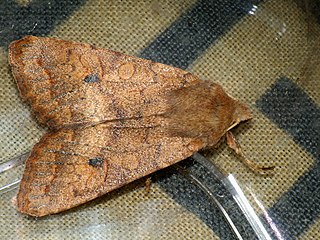
Agrochola circellaris, or The Brick, is a species of moth of the family Noctuidae. The species was first described by Johann Siegfried Hufnagel in 1766. It is distributed throughout most of Europe, Asia Minor and Armenia.

The marbled beauty is a moth of the family Noctuidae. The species was first described by Johann Siegfried Hufnagel in 1766. It is an abundant species throughout most of Europe east to the Urals, and it is probably the most common lichenivorous moth of the Palearctic realm.

Apamea monoglypha, the dark arches, is a moth of the family Noctuidae. The species was first described by Johann Siegfried Hufnagel in 1766. It is a common, sometimes abundant, European species. It is found in most of Europe except northernmost Fennoscandia and the southern parts of the Iberian Peninsula and Greece. The species is also found in Anatolia, Turkestan, Western Asia and Central Asia, Siberia and Mongolia. In the Alps it is found up to heights of 2,500 meters. The smaller subspecies sardoa is found on Sardinia and Corsica.

Apamea sordens, the rustic shoulder-knot or bordered apamea, is a moth of the family Noctuidae. The species was first described by Johann Siegfried Hufnagel in 1766. It is distributed throughout Europe, east across the Palearctic to Central Asia and to China and Japan. It also occurs in North America.
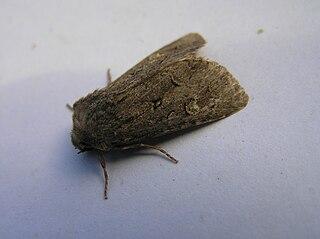
Luperina testacea, the flounced rustic, is a moth of the family Noctuidae. It is found in Europe, Asia Minor and Armenia.

Lithophane leautieri, the Blair's shoulder-knot, is a moth of the family Noctuidae. It is found in Europe. It originated from the area surrounding the Mediterranean Sea, but gradually moved north.

Lacanobia thalassina, the pale-shouldered brocade, is a moth of the family Noctuidae. It is found in Europe east across the Palearctic to the Russian Far East and Siberia.
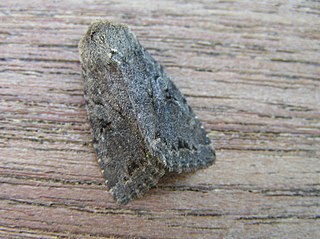
Fissipunctia ypsillon, the dingy shears, is a species of moth of the family Noctuidae. It is found in the Palearctic realm.

Pyrrhia umbra, the bordered sallow, is a moth of the family Noctuidae. The species was first described by Johann Siegfried Hufnagel in 1766. It is found in all of Europe, east through Anatolia to Iran, Afghanistan, Pakistan and Nepal and through central Asia to Japan. In mountains it can be found up to elevations of 1,600 meters.

Euxoa obelisca, the square-spot dart, is a moth of the family Noctuidae. It is found in the Palearctic realm.

Polia bombycina is a moth of the family Noctuidae. It is found in the Palearctic realm from Ireland to Japan including the Russian Far East and Siberia.

Pachetra is a monotypic moth genus of the family Noctuidae erected by Achille Guenée in 1841. Its only species, Pachetra sagittigera, the feathered ear, was first described by Johann Siegfried Hufnagel in 1766. It is found in central and southern Europe, east to the Ural, north to southern England, Sweden and Finland. Southwards it is found from Anatolia, central Asia and the Altai up to Mongolia. It is also present in North Africa.

Agrotis vestigialis, the archer's dart, is a moth of the family Noctuidae. The species was first described by Johann Siegfried Hufnagel in 1766. It is found in most of the Palearctic realm from Ireland east, through to Russia, Siberia, the Altai mountains and the Amur region, and is also present in the Mediterranean Basin. It is absent from the north of Finland and Norway.
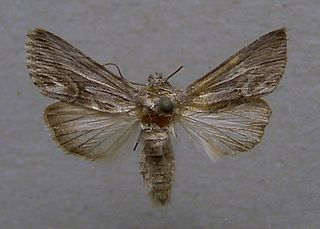
Calophasia platyptera, the antirrhinum brocade, is a moth of the family Noctuidae. The species was first described by Eugenius Johann Christoph Esper in 1788. It is found in Europe, the Near East, the western Sahara, Morocco, Algeria and Tunisia.

Lithophane socia, the pale pinion, is a moth of the family Noctuidae. The species was first described by Johann Siegfried Hufnagel in 1766. It is found throughout western Europe from Spain to central Scandinavia then east across the Palearctic to Siberia, the Russian Far East and Japan.
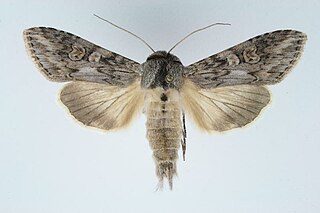
Cucullia artemisiae, or scarce wormwood, is a moth of the family Noctuidae. The species was first described by Johann Siegfried Hufnagel in 1766. It is found from central and southern Europe to Turkey and across the Palearctic to western Siberia, Central Asia, Manchuria, the Korean Peninsula and Japan.

Lithophane consocia, the scarce conformist or Softly's shoulder-knot, is a moth of the family Noctuidae. The species was first described by Moritz Balthasar Borkhausen in 1792. It is found throughout northern, central and eastern Europe, east to Siberia. There is a single record from Great Britain, where it was recorded in Hampstead, London, in September 2001.
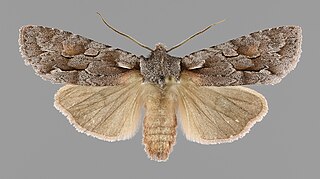
Lithophane lamda, the nonconformist, is a moth of the family Noctuidae. It is found throughout Europe, except in southern Europe. It is also absent from Iceland and Ireland.
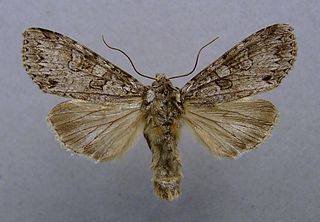
Polia nebulosa, the grey arches, is a moth of the family Noctuidae. The species was first described by Johann Siegfried Hufnagel in 1766. It is found in temperate Europe and Asia up to eastern Asia and Japan. It is not present in northernmost Fennoscandia and the southern parts of the Iberian Peninsula, Italy and Greece. In the Alps it is found at heights up to 1,600 meters.

Lithophane ornitopus, the grey shoulder-knot, is a moth of the family Noctuidae. The species was first described by Johann Siegfried Hufnagel in 1766 and is found in most of the Palearctic realm from Ireland east to Siberia.





















